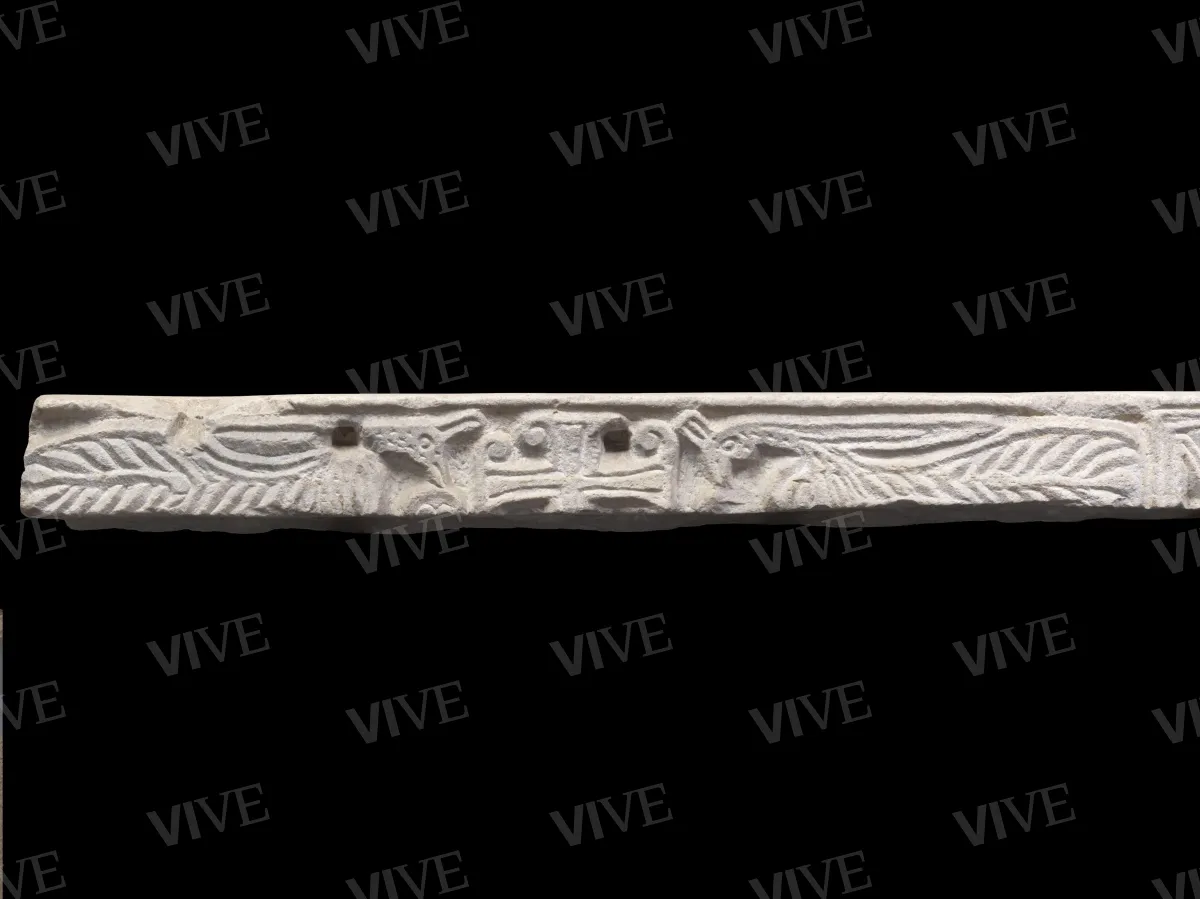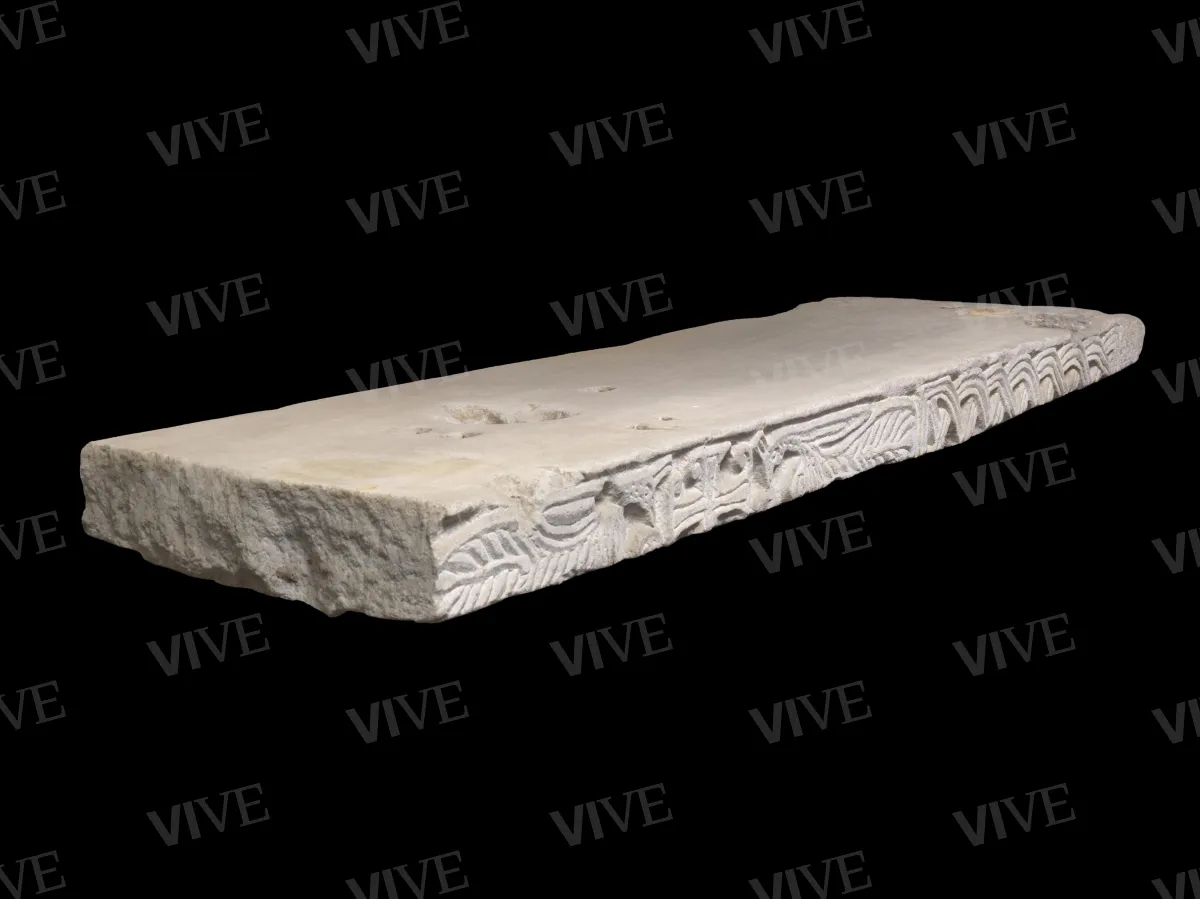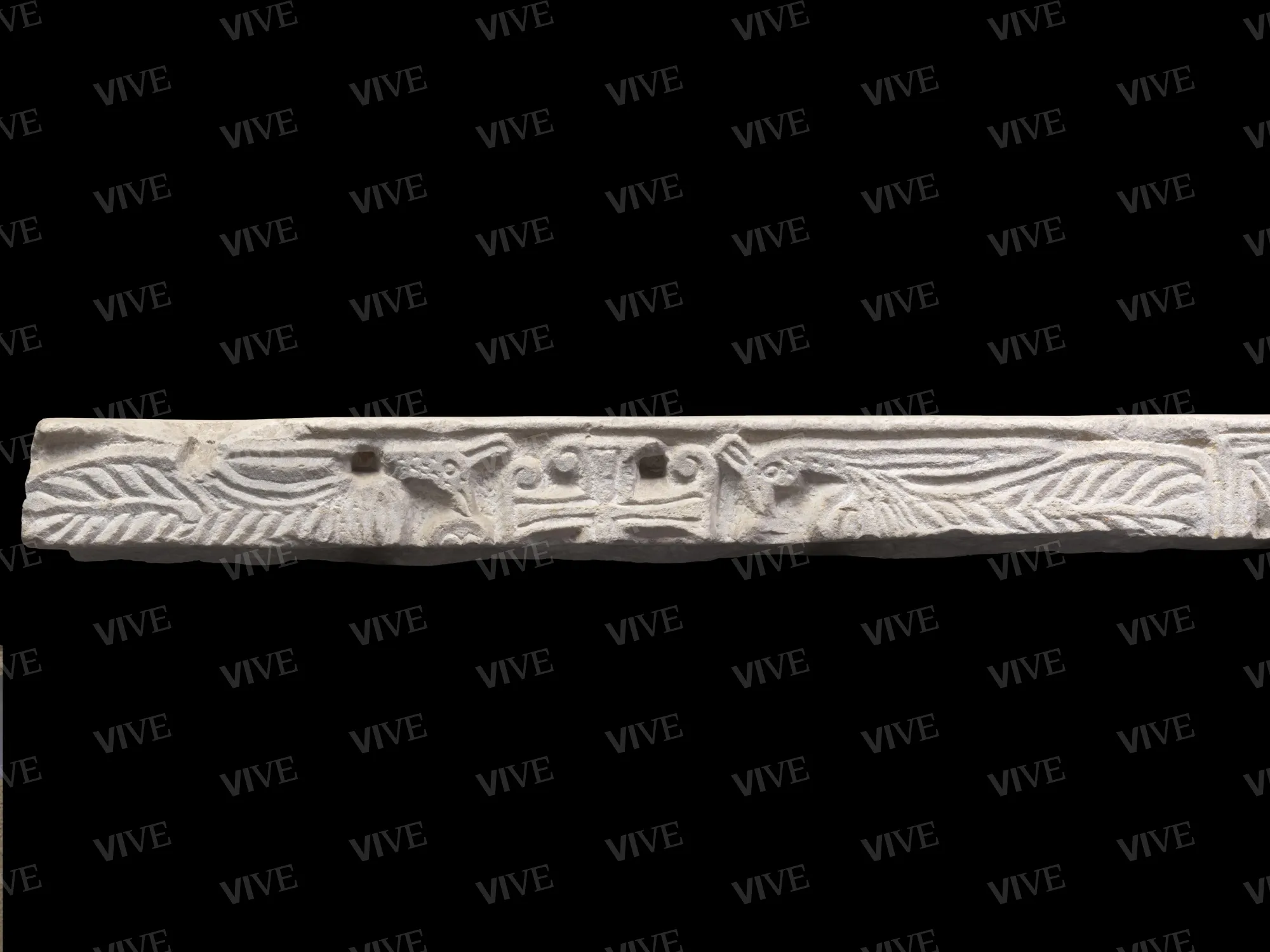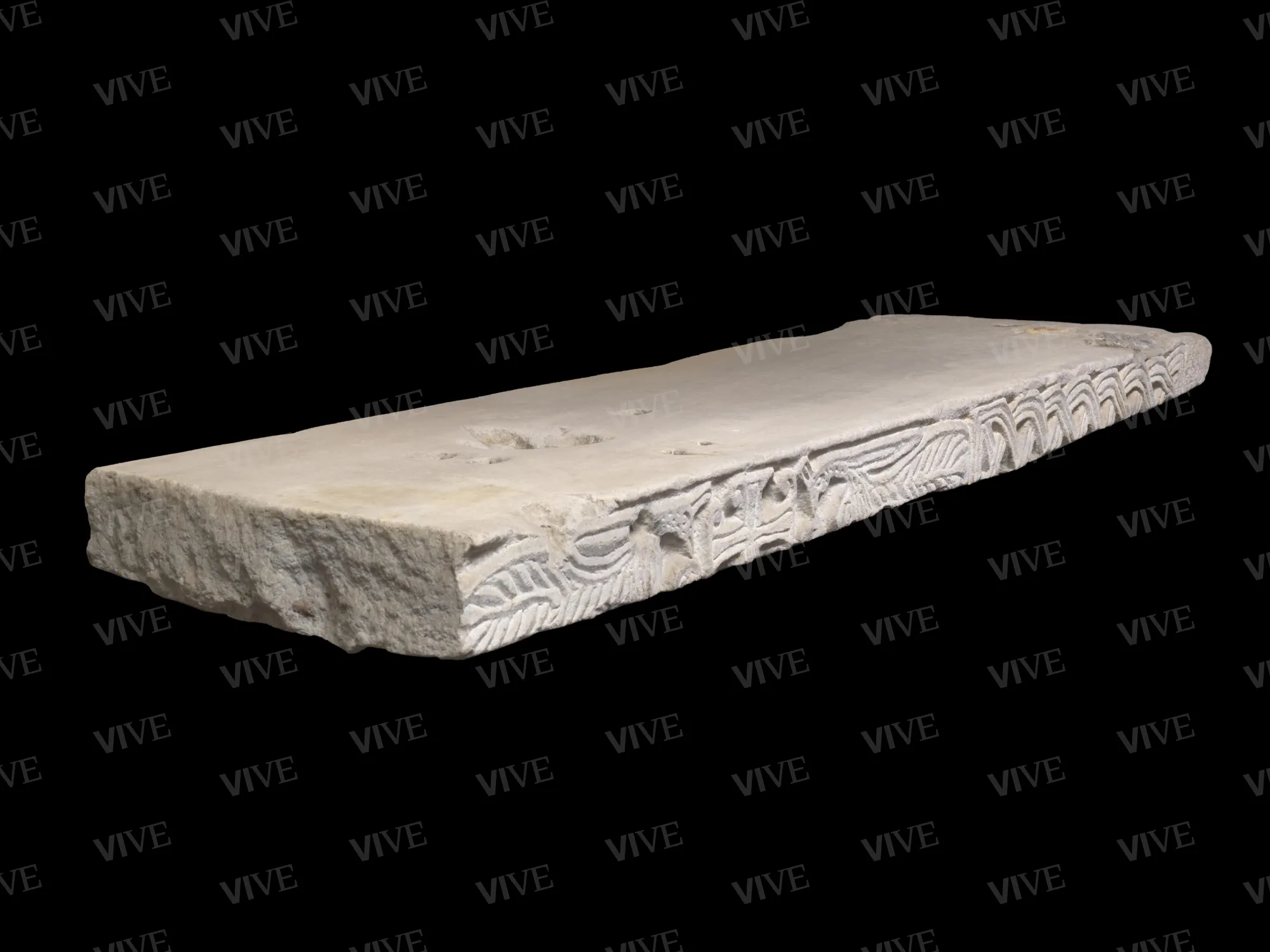Fragment of architrave with peacocks facing each other
Roman milieu Late-8th–first quarter 9th century
Fragment of marble architrave with plain listel frame, decorated with a pair of peacocks facing each other, pecking at a bunch of grapes on either side of a cross with scrolled finials, and a treble braid of two-lined wicker ribbon motif.
Fragment of marble architrave with plain listel frame, decorated with a pair of peacocks facing each other, pecking at a bunch of grapes on either side of a cross with scrolled finials, and a treble braid of two-lined wicker ribbon motif.
Details of work
Catalog entry
The long, deep marble fragment preserves clear iconographic fragments of the ornamentation that must once have decorated its front. Below a plain listel frame, to the left of the slab, a pair of peacocks facing each other on either side of a cross pattée with volute finials are depicted pecking at a bunch of grapes. This is an early medieval re-presentation of an iconographic item from early Christianity, long cultivated in the Byzantine sphere as a motif of nourishment, whose redemptive meaning, linked to the symbolic figure of the peacock as an image of the incorruptibility of the flesh, is interwoven with the Eucharistic meaning negotiated through the grape–blood image associate with Christ (Farioli 1983, Flaminio 2000). To the right of the slab runs a treble braid of two-lined wicker ribbon motif.
As with the fragment with interlaced decorations (inv. 13596) from the Palazzo Venezia Lapidarium, which we assume originally belonged to the same marble facing from an unidentified church, the wicker braid is composed of seven neatly distributed knots. In this part of the slab, the light–shade contrast is accentuated by the characteristic shell-like incision of the eyelets of the braided mass.
The fragment is cropped and chipped, as well as scored with holes—including some that cut through the entire slab—in all likelihood in an attempt to repurpose the slab. It must originally have been an architrave, as has recently been proposed (Guiglia 2019) through new comparisons and considering the slab’s size, which is more in keeping with that of an architrave than a presbyterial enclosure pluteus (which is, instead, a hypothesis put forward in Latini 2008).
The figurative ornamentation iconography itself would suggest that this is a pergula architrave (on the Carolingian pergula, see Ballardini 2016), especially considering the arrangement of peacocks and tails along the upper edge of the slab, even though in Rome the motif is more widely seen on ciborium archivolts (Melucco Vaccaro 2001), where it would more naturally be placed because of its intrinsically Eucharistic symbolism. In fact, the closest examples to our fragment are the reliefs decorating two ciborium arches from Sant'Andrea Cata Barbara (Pani Ermini 1974, fig. 11), where we also find the volute cross and the two-lined wicker ribbon braid motif, the execution of which can be dated to the restoration work on the church carried out during the papacy of Leo III (795–816).
It is safe to assume that the aniconic interlaced ribbon decoration, widespread in Roman sculptural production from the late eighth century on (Casartelli Novelli 1976), might have been replicated in the left half of the slab, on this side of the frieze with the peacocks. In fact, the association of the slab with the interlaced fragment mentioned above (inv. 13596) would give rise to an architrave in keeping with the dimensions (Guiglia 2019 calculates about 220 cm of overall length) attested in Rome, at the turn of the eighth and ninth centuries, of a presbyterial pergula (de Blaauw 1994, II, 530–566; Guidobaldi 2001).
The peacock bodies’ surface rendered with deftly executed strokes of the chisel, the perfectly round eyes and expertly engrave beaks, and the plumage rendered in rounded bands and distinguished by the long herringbone tails with ocelli all point to advanced technical prowess, thus bringing this work into line not only with the examples we have already cited from the church of Sant’Andrea Cata Barbara but also with a slab fragment from the Museo dell’Alto Medioevo (Melucco Vaccaro and Paroli 1995, fig. 41), dated to the first half of the ninth century, and with the fragmentary slab from San Clemente (Barsanti, Flaminio and Guiglia 2015, fig. 132), possibly from the Lower Basilica, which was also originally used as an architrave (now Guiglia 2019, fig. 4, where it is dated to between the eighth and ninth centuries). Similarly, the cross, which was probably Greek with webbed incisions, has starkly delineated volutes. The fact that the different techniques coexist in our fragment would suggest that it already belongs to the production of the workshops of Leo III (795–816) (Macchiarella 1976; Paroli 1998; Roperti 2007), which would be continued later in the workshops of Leo III’s successor.
Valentina Brancone
Entry published on 12 February 2025
State of conservation
Mediocre. Cropped, chipped, with holes, including two deep ones on the left side of the slab. The upper part of the slab is smooth, the lower rough.
Restorations and analyses
2002–2003 (restoration curated by Maria Giulia Barberini and Maria Selene Sconci, conducted on the occasion of the organization of the Museo di Palazzo Venezia Lapidarium).
Provenance
Unknown. Found during excavations around the Palazzetto as part of the demolition carried out during the relocation of the Palazzetto di Venezia (1910–1914).
Sources and documents
Rome, Archivio del Museo del Palazzo di Venezia, Bollettario, tome IV (handwritten annotation by Federico Hermanin, June 30, 1921);
Rome, Archivio del Museo del Palazzo di Venezia, inventorying the sculptures of the lower and upper loggias (manuscript inventory edited by Maria Vittoria Brugnoli, 1973).
References
Kautzsch Rudolf, Die römische Schmuckkunst in Stein vom 6. bis zum 10 Jahrhundert, in «Römisches Jahrbuch für Kunstgeschichte», III, 1939, pp. 3-73;
Pani Ermini Letizia, La Diocesi di Roma, t. I, La IV regione ecclesiastica, Corpus della scultura altomedievale, VII, Spoleto 1974;
Casartelli Novelli Silvana, L’intreccio geometrico del IX secolo, scultura delle cattedrali riformate e «forma simbolica» della rinascenza carolingia, in Istituto di Storia dell’Arte dell’Università di Roma (a cura di), Roma e l’età carolingia. Atti delle giornate di studio (Roma, 3-8 maggio 1976), Roma 1976, pp. 103-113;
Macchiarella Gianclaudio, Note sulla scultura in marmo a Roma tra VIII e IX secolo, in Istituto di Storia dell’Arte dell’Università di Roma (a cura di), Roma e l’età carolingia. Atti delle giornate di studio (Roma, 3-8 maggio 1976), Roma 1976, pp. 289-299;
Farioli Raffaella, Ravenna, Costantinopoli: considerazioni sulla scultura del VI secolo, in XXX Corso di cultura sull’arte ravennate e bizantina. Seminario Giustinianeo, (Ravenna, 6-14 marzo 1983), Ravenna 1983, pp. 205-253;
de Blaauw Sible, Cultus et decor. Liturgia e architettura nella Roma tardoantica e medievale, 2 voll., Città del Vaticano 1994;
Melucco Vaccaro Alessandra, Paroli Lidia, La Diocesi di Roma, t. VI, Il Museo dell’alto Medioevo, Corpus della scultura altomedievale, VII, Spoleto 1995;
Paroli Lidia, La scultura in marmo a Roma tra l’VIII e il IX secolo, in Delogu Paolo (a cura di), Roma medievale. Aggiornamenti, Firenze 1998, pp. 93-122;
Flaminio Roberta, s.v. Cantaro, in Bisconti Fabrizio (a cura di), Temi di iconografia paleocristiana, Città del Vaticano 2000, pp. 143-146;
Melucco Vaccaro Alessandra, Le botteghe dei lapicidi: dalla lettura stilistica all’analisi delle tecniche di produzione, in Roma nell’Alto Medioevo. Settimane di studio del Centro italiano di studi sull’Alto Medioevo (27 aprile-1 maggio 2000), XLVIII, vol. I, Spoleto 2001, pp. 393-420;
Guidobaldi Federico, Struttura e cronologia delle recinzioni liturgiche nelle chiese di Roma dal VI al IX secolo, in de Blaauw Sible (a cura di), Arredi di culto e disposizioni liturgiche a Roma da Costantino a Sisto IV. Atti del Colloquio internazionale (Roma, 3-4 dicembre 1999), Roma 2001, pp. 81-99;
Roperti Antonella, Note sulla scultura, in Bonacasa Carra Rosa Maria, Vitale Emma (a cura di), La cristianizzazione in Italia tra Tardoantico ed Altomedioevo. Atti del IX Congresso Nazionale di Archeologia cristiana (Agrigento, 20-25 novembre 2004), vol. I, Palermo 2007, pp. 411-420;
Latini Massimo, Catalogo, in Barberini Maria Giulia (a cura di), Tracce di pietra. La collezione dei marmi di Palazzo Venezia, Roma 2008, pp. 175-194, schede 1-29;
Barsanti Claudia, Flaminio Roberta, Guiglia Alessandra, La Diocesi di Roma. La III regione ecclesiastica, Corpus della scultura altomedievale, VII, 2 voll., Spoleto 2015;
Ballardini Antonella, Stat Roma pristina nomine: nota sulla terminologia storico-artistica nel Liber Pontificalis, in D’Onofrio Mario (a cura di), La committenza artistica dei Papi a Roma nel Medioevo, Roma 2016, pp. 381-439;
Guiglia Alessandra, Aggiornamenti sulle sculture altomedievali del complesso di San Gregorio al Celio, in Caglioti Francesco, Lucherini Vinni (a cura di), Inedita mediævalia. Scritti in onore di Francesco Aceto, Roma 2019, pp. 237-246.














